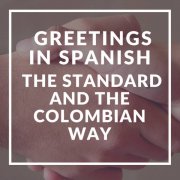How learning about Colombian culture can help you improve your Spanish communication skills
Learning a new language is not only about memorizing verbs, learning new vocabulary, and improving your grammar. When learning a new language, you should also learn about the culture!
It is true that, by and large, once you learn General Spanish you will be able to communicate with any Spanish speaker. And Colombia -especially Bogota- is known for being one of the best places to learn Spanish.
However, we all know that each country and culture has its customs, traditions and ways of communication, and Colombia is not an exception!
So, if you want to travel or live in Colombia, or if you are in a relationship with a Colombian person, there are certain things you need to know to connect more with the people!
What’s Colombian Spanish?
Colombian Spanish is a group of dialects of Spanish spoken in Colombia. Since the dialects spoken in the various regions of Colombia are quite diverse, the term Colombian Spanish is of more geographical than linguistic relevance.
It is important to note that when referring to “Colombian Spanish,” people commonly refer to the formal and standard dialect spoken in Bogota. This dialect is generally well known for being probably the clearest Spanish to understand and the easiest Spanish to learn.
Our language has gained popularity among non-native speakers willing to learn or improve this language.
What Makes Colombian Spanish Different?
Well, here is the thing, it’s important to know that Colombia is often defined as a high-context culture. This means that the background information to interaction is often contained in the context, and one’s status and position don’t always need to be explicitly expressed in communication.
“High context cultures are those cultures in which members share and require a deep, complex body of ‘understood’ values and experiences. This means many aspects of living and communicating are inherently assumed, as much of the meaning informing communication is implied in the context. People’s position or intentions in society are often easily distinguishable by their appearance or status. Therefore, high context cultures generally rely on indirect communication. Messages are more understated and laced in ambiguity and more meaning is drawn from the context. “
In this sense, to talk about Colombian Spanish, we need to differentiate between the formal and informal use of the language.
Formal Colombian Spanish
It’s the language we use in formal contexts such as academic, professional, and family environments. That’s the language that it’s worldwide known for being “the most neutral, clear and easier to understand.”
There are different forms of expression that communicate varying levels of courtesy and formality. And, it’s essential to understand that in the formal use of the language, we don’t use slang and certain popular expressions.
Two quick examples of the formal use of the language:
The use of the pronoun “usted” as the formal form of “you”. This is a polite form of speech to address any one of a higher status out of respect.
The use of courtesy words such as “por favor”, “muchas gracias”, “con gusto”, “disculpe”, among others.
Friendly and informal Colombian Spanish
Here comes the fun!
It is in this context when our language slightly varies. Or better said, we spice it up!
Why’s that?
Colombians are known for being expressive, very good talkers and for introducing humor into conversations. Also, for being open with our emotions, for making jokes, and for our sarcasm!
However, paradoxically, we are also known for being indirect communicators. We don’t usually express our opinions frankly or bluntly, and we tend to avoid conflict or confrontation.
When giving negative answers or opinions, we often take a long-winded, roundabout approach to conveying messages sensitively and tactfully.
For example, It is common to hear “I will see what I can do” instead of giving a straight “no”.
In a friendly and informal context, the use of the language is characterized by the use of slang, popular expression and double meaning jokes.
So, if you want to understand Colombians truly, a deep knowledge of our culture is needed.
Quintessential Colombian Spanish
Easily, we could write a book about Colombian Spanish. But in this article, we prefer to guide you through a series of articles we have been writing during the last year, in which you can deepen your Colombian Spanish knowledge.
Colombian Slang
We use many words daily that have no translation or need a “literal” translation and a Colombian Spanish translation.
For instance:
- If you hear someone referring to another person as “avión”, or if someone says they have “mucho camello”, stop and try to get the whole picture.
It doesn’t mean another person is an “airplane”, or someone has many “camels.” It means someone is taking advantage of someone/something (Avión), and someone has too much work to do (camello) - When someone asks you to go for a “tinto,” it doesn’t mean going to get some “red wine”… They are asking you if you want to get a black coffee!
- There are several verbs that can mean two different things depending “on the context.” Like, for example, “regalar” means” to give something as a present,” but in Colombia, we ALL use this verb when ordering food, coffee, or when asking someone for time/space to talk.
Only in Colombia is this verb used as a polite way of asking for something. - There are many popular words such as “tusa”, “ñapa, or “parche” that you will frequently hear, which don’t have a literal translation and that you need to simply learn them!
- Or, eventually, you will learn that we make up verbs out of many slang words. For example, “camello” (job) and “camellar” (to work), or “parche” (group of friends) and “parchar” (to hang out).
- Once you think you know it all, you will find words that can mean different things. Like “vaina”, the most used and versatile word in Colombian Spanish. This one needs practice, and that’s why we wrote an entire article only about the use of this word.
You can learn more about Colombian Spanish Slang by checking out this list of helpful resources.
- 20 words that only make sense in Colombia
- 30 Colombian slangs and what they mean
- 20 slang expressions we only use in Colombia
Sayings and Expressions
When it comes to humor and double-sense jokes, no one beats a Colombian!
Our best advice: Don’t take things too seriously!
There are hundreds of sayings and expressions. Read this article to get a glimpse of how we, Colombians, talk among friends “20 funny Colombian expressions and what they mean”
Learn some and surprise your Colombian friends next time you talk to them!
Or, if you are into Colombians, you need to learn these “35 Piropos (compliments) in Colombian Spanish“.
Be aware that there are “piropos” of all kinds; those that sound like a romantic poem and those vulgar and sexist. That is why when saying a “piropo” you should be very careful on when, where, and to whom you say it. It can be a double-edged sword because they could be sublime or gross.
Remember, the trick is to break the ice, spice up the conversation while keeping yourself elegant and proper.
Diminutives
Another important aspect you should keep in mind -and learn- is the use of diminutives. This is quintessential Colombian Spanish!
We use diminutives to convey the meaning of specific words more softly or affectionately. This is usually done by simply adding ‘ito’ or ‘ita’ to the end of a word.
For example:
Cafecito (coffee)
“Vamos por un cafecito?
Shall we go for a coffee? (It doesn’t necessarily mean a “little coffee”)Hermanita (Sister)
“Tengo que ir a recoger a mi hermanita”
I need to pick up my sister (It doesn’t necessarily mean “younger sister”, it could even be a 25 years old sister. It’s used just to express affection)Juiciosita/o
“¿Qué haces? – Nada especial, acá juiciosiota en casa”
What are you up to? – Nothing special, just chilling at home (This one you will hear often).Calvito (bald)
¨Quién? El calvito que está allá?¨
‘Who, the bald guy over there? (When it refers to a physical aspect of a person, we generally use a diminutive just to avoid being offensive).Carlitos (affectionate way of saying the name ¨Carlos¨)
Ayer me encontré con Carlitos, fuimos a cenar.
Yesterday I met Carlitos, we had dinner together.
Shortening the Words
Sometimes, words are long and sound a bit weird to add an extra -ito or -ita. In those cases, we can also shorten it.
For example:
Cumple (Birthday)
“¿Me acompañas a comprar una camisa para el cumple de mañana?”
Would you come with me to buy a T-Shirt for tomorrow’s Birthday?Uni (Universidad)
“Voy a pedir un Uber para ir a la Uni”
I´m calling an Uber to go to my uniJuan Fernando.
This is an example of how we would shorten some proper names
“¡Llama a JuanFe a ver si viene con nosotras!”
Call JuanFe, maybe he wants to join us!
Non-Verbal Communication
Non-verbal communication is a super important part of Colombian culture.
Here is a list of things you should keep in mind:
Physical contact and personal space
Colombians are generally very tactile people. We like hugging our friends and family relatives. We may gently grab your arm or leg to reinforce a specific point in a conversation when talking. Or, sometimes, people like to get close to the person they are talking to make a point.
Putting an arm around your shoulder in a friendly and affectionate way is entirely normal.
When dancing, physical contact is also super important, and it doesn’t necessarily mean sexual attraction.
All these things are not “the rule,” and there are regions where it happens more often, in the Caribbean or Pacific region, for instance.
For some people, physical contact could be uncomfortable. So, if that’s your case, make sure you express politely you are not used to it.
Eye Contact
Direct eye contact is completely normal and expected. Avoiding another person’s gaze may imply guilt or dislike.
Pointing or indicating someone’s height
It is considered inappropriate to beckon people with your index finger alone. If beckoning, wave towards yourself using your entire hand.
Also, it is considered rude and aggressive to point with the index finger. People may gesture towards something by pursing their lips (as if to kiss, see next section) in the direction of the person.
Colombian Gestures
In addition to the non-verbal things listed above, there are many gestures that we frequently use in Colombia to express feelings, opinions, or emotions.
They are unique and interesting!
Where did those gestures come from?
We have no idea! What we do know is that learning these gestures will make you a step closer to Speaking fully Colombian Spanish!
Our best advice is always to try to be aware of the context of the conversation. And, of course, to practice!
Read books, listen to music, watch movies and talk to your Colombian friends or teacher; that definitely helps!
So, go ahead, try, make mistakes, learn, and most of all, have fun!











